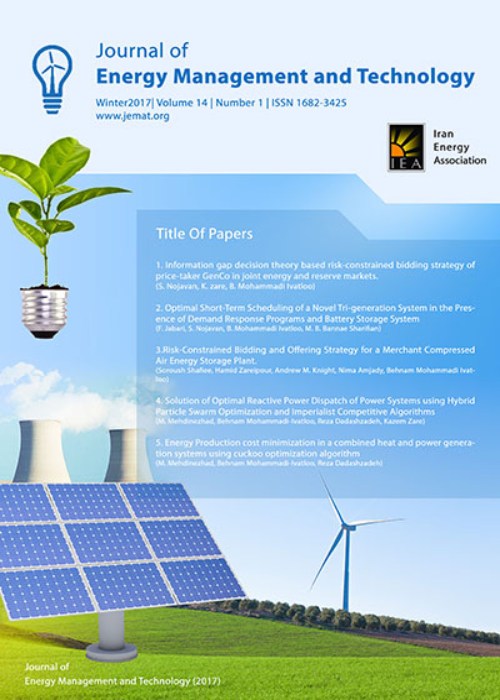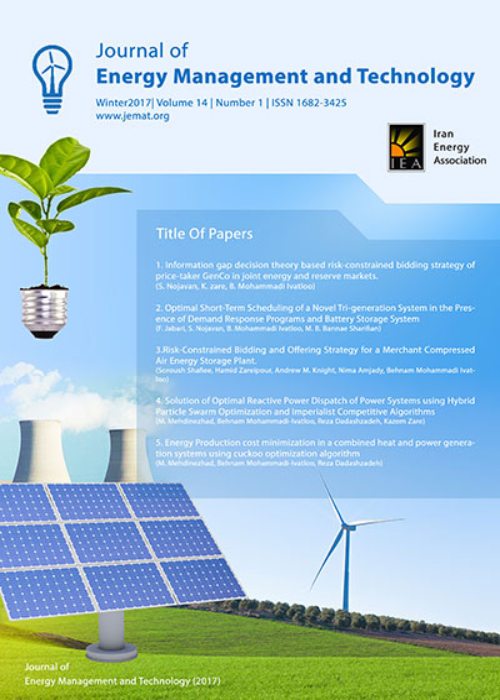فهرست مطالب

Journal of Energy Management and Technology
Volume:7 Issue: 3, Summer 2023
- تاریخ انتشار: 1402/06/10
- تعداد عناوین: 7
-
-
Pages 125-133
The environmental pollution problem is intensified in recent years due to increasing fossil fuel consumption. In this regard, deployment of renewable resources can be a practical solution to decrease greenhouse gases and global warming. This paper proposes a risk-aware multi-objective programming consisting of operation cost and pollution objective functions to optimize the operation of a renewable hybrid microgrid composed of biomass-based conventional generators, wind turbines, photovoltaics and electrical and heat storage systems. According to the presence of uncertainties in such infrastructures, fluctuations of wind speed, solar radiation, loads and market price are modeled through a scenario generation and reduction procedure and then, the conditional value-at-risk index is used to measure the risk of decisions. Moreover, the epsilon constraint and fuzzy logic approaches are utilized to solve the problem and select the best solution in the Pareto set, respectively. A demand response program is also implemented for electrical and heat loads to analyze the influence of responsive loads. The results validate that the operation cost and pollution increase by about 10.03% and 11.31% in the risk-averse strategy, in return, robustness in the worst-case scenarios improves. As well, responsive loads decrease operation cost by about 9.8% under the uncertainties, however, the pollution increases by about 0.88%.
Keywords: Demand response program, Energy storage systems, Multi-objective Programming, Renewable microgrid, Risk Analysis -
Pages 134-141Given the importance of unit commitment risk (UCR) assessment in determining the probability of meeting load demand in the ahead short-term operation period, in this paper, a new analytical model for UCR assessment is presented. In the proposed model to consider the impact of wind power participation in the entire short-term period of operation of the system, using the developed risk area concept, a new model for UCR assessment is presented. Furthermore, uncertainties of wind power and load demand are considered simultaneously. Unlike the models presented in previous research for UCR assessment, which consider the share of wind power in the last period of operation, the proposed model for UCR assessment considers the share of wind power in all periods of operation. The proposed model was tested and evaluated on the RBTS system with a wind farm. Moreover, the results obtained from the simulation were reported. According to the results, in all cases, the value of UCR in the proposed model is lower than the modified PGM (M-PGM) method. The effectiveness of this innovative approach in evaluating the UCR of the power system despite wind power and load uncertainties was confirmed based on the results.Keywords: Reliability, unit commitment risk, wind power, risk area, Uncertainty
-
Pages 142-152Generation maintenance scheduling (GMS) is one of the most important and influential programs on short-term scheduling. On the other hand, the variability nature of distributed renewable resources is led to the need for a power system to provide flexibility. In order to achieve a flexible operation, it is essential to develop a flexible GMS framework. For this purpose, it has used the flexibility index of the system in order to evaluate the flexibility of the power system. In flexibility studies, modeling and predicting the variability of renewable resources is important. Gas-fired power plants are one of the most important suppliers of flexibility in the supply-side. Therefore, the reliable operation of electricity grids depend on the natural gas availability . Furthermore, gas demand is subject to various uncertainties, especially in cold seasons, which will have significant effects on power system. In this paper, the uncertainties of wind and gas load is considered through forecasting by ARIMA method in Python. In this paper, natural gas and electricity demand responses are implemented as flexibility provisions from demand-side resources. It is worth noting that the objectives of increasing flexibility, leveling the energy index of reliability and reducing emission and costs have been considered as the objectives of optimizing GMS . The proposed framework is implemented on a modified IEEE 24 bus. According to the results, the system flexibility has been improved without increasing costs. The flexibility index in proposed model has improved by about 19.11%, due to the use of DRRs.Keywords: Generation maintenance scheduling, Gas load uncertainty, augmented epsilon constraint method, flexibility
-
Pages 153-164This paper proposes two novel structures to identify potential sites for wind-solar power plant construction, along with the optimal capacity ratio of wind-to-solar power plants in each region. The first structure comprises three modules, namely, identifying the best wind turbine and its output power, predicting global tilted irradiation at the optimal angle, and obtaining the capacity ratio of wind-to-solar power plants. The second structure is used to identify regions with the highest energy harvesting potential per square meter by evaluating the algebraic sum of two Capacity Factors (CFs) and determining the capacity ratio based on the maximum installed capacity of each power plant in that area. The results of applying these structures to 4900 points in Iran show that the solar power plant CF is higher than 20% in more than 95% of the selected points, while the CF for wind power plants was only above this threshold in 12% of the examined points. The selection of the optimal wind turbine significantly affects the CF and output power, and hybridization of the two power plants has little effect on improving the CF. Less than 10% of the areas were deemed suitable for constructing hybrid power plants. This study provides valuable insights into identifying potential areas for wind-solar power plant construction and determining the optimal capacity ratio of wind-to-solar power plants. The proposed structures can assist policymakers and industry experts in making decisions about where to build wind-solar power plants, helping to increase the efficiency of renewable energy generation.Keywords: Capacity factor, Optimum ratio of wind turbine capacity to solar power plant capacity, Renewable Energies, solar power plant, Wind power plant
-
Pages 165-173This research evaluates the performance of the two most utilized light-vehicle engines in Tehran, Iran. This paper aims to assess exhaust gas emissions of blended ethanol-gasoline combustion in two of Iran's national engines, TU5 and EF7, at different engine speeds. For this, exhaust gases, including CO2, CO, HC, and NOx, are analyzed using ANOVA statistical analysis. Fuel samples with 0, 20, 40, 60, and 80 vol.% ethanol in gasoline are tested in the TU5 and EF7 engines at different engine speeds, i.e., 850, 1000, 2000, 3000, and 4000 rpm. Findings suggest that the amount of exhaust gases is majorly dependent on the engines' characteristics, particularly the air-to-fuel equivalence ratio. According to the experimental results, CO2, HC, and NOx emissions from the EF7 engine are higher than the TU5 engine at all speeds. CO is higher in the TU5 case, on the contrary. As per the variance analysis results, exhaust emissions are primarily contingent upon and influenced by the oxygen rate required for combustion, fuel richness, and cylinder temperature rather than the composition of ethanol-gasoline blends.Keywords: Ethanol-gasoline blends, Exhaust Emissions, Engine kinds, Pollution
-
Pages 174-183
Using the virtual resistance control method to reduction oscillations in the input LC filter of AC-DC rectifiers This paper examines an important topic called Total Harmonic Distortion (THD) of input current in ac-dc rectifiers. It is especially important in high-power electric vehicle charging stations, which causes oscillations in the power grid.Since the in the rectifiers the input LC filter has the role of filtering and reducing oscillations.In this paper, changes are applied to the rectifier controller, which makes the LC filter behave like an RLC filter.which causes the damping of the input current oscillations to the power grid. Since it does not use any real resistance, the efficiency of the converter does not decrease and losses do not increase. Therefore, it is called virtual resistance control method. It can be considered in series or parallel with inductor or capacitor.This research is to reduce oscillations in high power loads in steady state, which can reduce losses in the filters of the chargers. In the following, the simulation results of the battery charger rectifier are in steady state, And finally to validate it The proposed method has been implemented in a laboratory and the results have been displayed.
Keywords: battery charger, Electric Vehicle, converter, Rectifier, virtual resistance -
Pages 184-191
The Kalina cycle utilizes low-temperature heat sources to generate high-pressure vapor for running a turbine to produce power. Since the vapor at the turbine exit is relatively low temperature, a cool medium is required to liquefy the vapor at the condenser. This requirement imposes a practical limitation to the Kalina cycle for application in hot and dry regions. This paper studies the environmental and economic impact of using air-cooled condensers in the Kalina cycle. A dual Kalina cycle (KSC-D), the hybrid dual Kalina cycle (KSC-Dh), and the basic Kalina cycle (KSC-1) have been compared, considering Tarasht Steam Power Plant, as a case study. Subsequently, power output, water consumption, CO2 emission, and IRR , NPV were investigated for each case. Results show the least power output (4346704 kWh year-1) and the maximum power output (5008627 kWh year-1) belong to the basic Kalina cycle with an air-cooled condenser (KSC-1a) and the KSC-Dh cycle, respectively. Moreover, using air-cooled condensers in the dual Kalina cycle (KSC-Da) saves about 425825×103 m3 of water annually. KSC-Da is the most cost-effective and has the shortest payback time of three years. Also, for KSC-Da, the natural gas saved is 0.7765 to 1.22 Mm3 year-1, and the reduction in CO2 emission is about 4378 Tons year-1. The overall results indicate that although the KSC-Da ranks fourth in terms of power output among the different cases (producing 4564262 kWh year-1), it is still the most viable choice regarding the impact on the environment and reducing the amount of CO2 emissions.
Keywords: CO2 emission, Dual Kalina cycle, Heat Recovery, Water Consumption, Water-cooled condenser


